 Menu
Menu
|
Function To study the connections between capacitor |
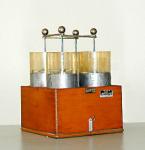
| ||
|
|||
|
Description The four separately removable jars are contained in a case of shining wood with four sections and with a metallic bottom. The metallic bottom is connected to a hook. The inner armatures are connected in parallel by four conductors connected with screws, so as to allow the use of every capacitor separately. | |||
|
Function It is used to measure the electricity supplied to a capacitor. |
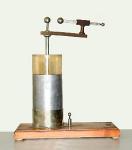
| ||
|
|||
|
Description Leyden jar of 231 cm, with a spark gap with a millimetre graduated scale and a vernier. The support of the spark gap is made of ebonite and it is attached to the conductor or the inner armature of the jar. | |||
|
Function To show the electric resonance. |
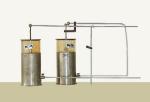
| ||
|
|||
|
Description The two jars have the outer armatures made of a nickered brass sheet, with connections for the lateral conductor of resonance. The first rectangular circuit, made of a big aluminium wire, includes the first Leyden jar and the spark gap movable by hand with its ebonite support. The second circuit is formed by the second jar and by two parallel aluminium wires supported by an ebonite support. Against the latter and perpendicularly to it, there is a third conductor movable by an ebonite handle. If the conditions for the oscillating discharge are satisfied, we have a close oscillator and a close receiver, that can become tuned by shifting the mobile conductor. In that case, the discharge in the adjustable spark gap placed on the armature of the second capacitor will correspond to the discharge of the first capacitor. | |||
|
Function To study the characteristics of a plate capacitor. |
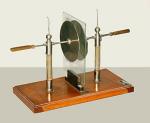
| ||
|
|||
|
Description This is the classic capacitor, with two metallic sliding plates supported by insulating columns, separated by a painted glass sheet. The small pendulums indicate the presence and the quality of the electric charge. | |||
 Menu
Menu
|
Function It is used to discharge the Leyden jars. |
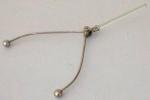
| ||
|
|||
|
Description The two dischargers, ending with two spheres, are hinged and independent one from the other on a single glass handle. A set screw in the hinge allows to fix in a stable manner the position of the two arcs. | |||
|
Function To study the laws on the action between electric charges and between magnetic poles. |
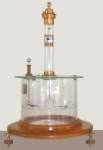
| ||
|
|||
|
Description The cylindrical glass container rests on a mahogany circular basis with brass foot screws. It has a grade division at half height. The cover is a glass disk that rests on the container and is driven by three ebonite rolls. From the centre of the cover a glass tube rises with a friction turning graduated head. The height of the set can be regulated, as the joint of the suspension is assigned to a sliding bar. As accessories of the apparatus we have:
| |||
 Menu
Menu
|
Function Instrument for the measure of the electric charge. |
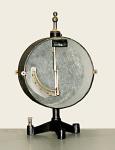
| ||
|
|||
|
Description The insulation is made of ebonite and sulphur. The cylindrical zinc case can be closed with two zinc covers, that leave a little opening in correspondence of the scale. The tripod has a binding post to earth the case and a foot screw. As accessories we have a metallic plate to replace the sphere and a second metallic plate with an insulating handle and a varnished glass disk, to change the instrument into a condensing electroscope. | |||
|
Function Instrument for the measure of the electric charge. |

| ||
|
|||
|
Description The metallic case is insulated but it is equipped with a lower hook to earth it. The two aluminium leaves are held by a shining sheet, insulated by a big ebonite sleeve and a sulphur cylinder. The two parallel sliding planes defend the leaves and are used to modify the sensibility of the instrument. To give the leaves a sufficient charge we rub the plate collector with a feather duster, without stopping on the plate, and with the case on the earth. If we want to give the leaves a charge opposite to the previous one, then we must eliminate the earthing, we rub the case with the feather duster and we touch the nickered plate. During this second operation it is advised not to rub the glass wall with the feather duster, because the leaves would be attracted violently and they would break. The capacitor plate must be handles with the ebonite end by which the glass column ends. The instrument is equipped with a thin glass disk to use as a dielectric. It must be interposed between the two plates to form the capacitor. | |||
|
Function To execute with precision the quantitative experiments the electrostatic induction. |
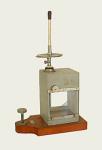
| ||
|
|||
|
Description The prismatic aluminium case is fixed on a mahogany basis, that has two ebonite feet and a leveling screw. To insulate the case we must place an ebonite disk under the leveling screw. The instrument is equipped with a small plate manoeuvrable from the outside, that can close the leaf against its support and always defend it. The same small plate, placed nearer or farther from the leaf changes the system capacity and earthing and transforms the electroscope into Gaugin’s electrometer. The instrument is equipped with a capacitor plate and a varnished glass disk. | |||